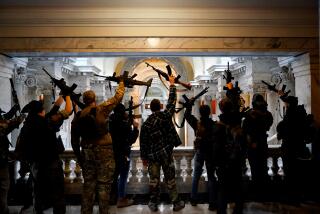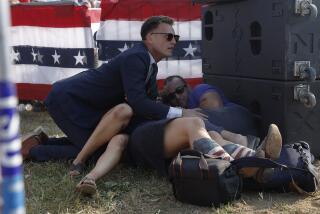James Brady Still Fights Pain, Gun-Control Foes : Firearms: The former press secretary was wounded with President Reagan in 1981. He doesnât want pity, just support for his causes.
WASHINGTON â A bullet pierced his brain 10 years ago and launched James S. Brady on a tour of hellâs amusement park--torturous therapy and terror at every turn.
Through it all, the former White House spokesman has maintained a seemingly indestructible sense of humor.
It was that same anything-for-a-laugh attitude that got him temporarily bounced off the Ronald Reagan campaign plane for making light of the candidateâs remark that most pollution is natural: Pointing at a forest fire, he called to reporters: âSee--killer trees! Killer trees!â
Not long ago, when asked the secret of his prize-winning chili, Brady answered without hesitation: âRoad kill,â referring to the meat of animals killed on the highway.
Shot in the head as John Hinckley Jr. wounded President Reagan in an assassination attempt in March, 1981, Jim Brady doesnât want pity. He wants support for his causes--gun ownership restrictions and a fair shake for disabled people.
He is confined to a wheelchair most of the time, but the Bear (his nickname for himself) says he continues to improve.
Slowly.
He is still in therapy several days a week. Horseback riding on a cagey mare named Bernie improves his balance, but it is agony to secure his legs in the stirrups. He takes what he calls âa pharmacyâ of medications to counter the lingering effects of his wound.
The problem is not just that he tires after only a few steps, or that he can no longer go on outrageous shopping sprees or roughhouse with his son, Scott. He must wear a balloon contraption at night to cope with swelling in his left leg; his left hand lies useless in his lap, yet it hurts constantly.
To Jim Brady, anything can be an obstacle.
âItâs sheer terror to go to the bathroom, because youâre standing up in a place that is marble city,â he says. âAnd you know that if you go down, youâre going to hit your head and youâre going to kill yourself.â
Brady, 51, keeps bitterness and anger in check most of the time. Still, he can work up âa good rageâ in 10 minutes.
âBut thatâs, essentially, a negative exercise,â he said. âPlay the hand thatâs dealt you.â
Nevertheless, the frustration and anger of a proud, smart, exuberant man who has had to relearn lifeâs most basic functions while enduring excruciating pain comes through in a recent television movie about his life.
The movie, based on the book âThumbs Upâ by Mollie Dickenson, does not depict the gallant victim featured on many disease-of-the-week shows. Although that side was included, actor Beau Bridges also portrayed Brady as occasionally cantankerous and downright nasty. In one scene, he lashes out with his cane at his wife, Sarah, nicknamed The Raccoon.
Brady maintains that he is not such an ogre and that he never hit his wife, who chairs Handgun Control Inc. and has championed the firearms legislation named for her husband.
âI never beat The Raccoon in the boobs with my cane, as one scene showed there,â Brady said. â . . . I thought the movie made me look much meaner than I am. Iâm really a pussycat.â
Yet Brady did not ask that such scenes be cut.
Other parts of the movie also caused him some chagrin. In one scene he is shown âwetting my pants, which embarrassed the hell out of me. Not that I donât do that. . . . Thatâs a constant problem, because the thing that tells that to stop was blown away.â
Brady is as brutally honest about other frustrations. He complains at one point that he is financially dependent on his wife. He also receives government benefits and support from a foundation that his friends established after the shooting.
âIt does nothing to my sense of self-esteem not to be the breadwinner, but Iâm not, and she constantly reminds me of that,â said the former impulse-buyer. âSheâs a loving wife,â he said, but sheâs ânot Mother Teresa.â Sarah Brady agrees.
A voluble man, Brady speaks with far more humor and lucidity in personal conversation than he does in most public appearances. But he falls momentarily silent when asked whether he has any fun these days.
âIâm trying to think if Iâve had fun in the last several months,â he said quietly, tapping his cane against his wheelchair.
Then he recovers his equanimity: âI entertain myself. I think Iâm a hoot.â
The impediments just to getting around offer Brady plenty of fodder for wit. He knows the indignities disabled people who travel by air must face, since he is on the move about three times a week as gun-control advocate, vice chairman of the National Organization on Disability and co-chairman of the National Head Injury Foundation.
Such problems can seem hilarious when described with Bradyâs deadpan humor and sound effects often impossible to describe.
One thing he hates is the so-called aisle chair--essentially a narrow, high-backed chair with straps--that is used on occasion to carry him up to the plane door.
âThey get the biggest ramp men you can find and they pull you up the damn stairs, all the way up. When you get to the top, you want to go like this,â he said, waving to an imaginary audience below. âHere is the trashing of this man. Watch him go up, folks.â
And then there was the matchless move by one airport--location undisclosed--where he was âloaded into a plane in the bucket of a front-loader.â
âThey put chains across so I couldnât roll out,â he said, laughing. âThe guy drove into the plane and went foomp! and the co-pilot stuck his head out the window to see if this fool on the ramp who had just driven a front-loader into his aircraft had hurt his plane or not.
âMy heart was going boom-boom-boom-boom-boom! I was afraid they were going to get me up there and go pfffft! with the bucket (he makes a flipping motion with his hand) and then Iâd go ka-boom! . . . I know front-loaders well, and I know they have minds of their own.â
Watching television has its own hazards. Even Brady canât find any humor in news replays of Hinckleyâs attack.
Each time he sees himself get shot, Jim Brady relives the moment.
âI want to take every bit of (that) film, of that incident . . . and put them in a cement incinerator, slosh them with gasoline and throw a lighted cigarette in,â he said.
Rather than dwelling on the hated images, Brady has focused on preventing future attacks.
Sarah Brady, who joined the board of Handgun Control Inc. in 1985 and became its chairwoman four years later, got into the gun-control cause long before Brady did.
In fact, Brady opposed her initial move.
Though he hadnât worked regularly since the shooting, he was still Reaganâs official spokesman and at the time, Reagan didnât publicly support the so-called Brady Bill and the waiting period it required for buying handguns.
Reagan came out in favor of the bill last March--on the 10th anniversary of the shooting. His support boosted the measureâs prospects, but the crime bill in which it was included failed under the weight of President Bushâs opposition to other parts of the legislation.
Brady said that if the waiting period had been law in 1980, when Hinckley purchased the gun he used, he might not have armed himself so easily. âAnd thereâs a good chance that I wouldnât be sitting in wheels today and walking around with a stick.â
Talking about Hinckley still gets under Bradyâs skin. Hinckley has been in St. Elizabethâs Hospital in Washington since 1982, when he was found innocent of criminal charges by reason of insanity.
Occasionally, Hinckley has asked the court to release him for a day or a weekend. He sought permission several years ago to leave the country with his fiancee, a former mental patient found innocent by reason of insanity in the 1982 shotgun slaying of her 10-year-old daughter.
Brady has little tolerance for such requests, or for Hinckleyâs âextensive correspondenceâ with Charles Manson, the cult leader serving life in prison for the 1969 murders of actress Sharon Tate and others, âand all these other storybook heroes.â
Hinckley has never apologized to Brady.
âWhy apologize for something that youâre not all that sorry about?â Brady asked.
Brady said he is in the gun-control fight for the long haul, even if the Brady Bill becomes law. Another measure he backed this year would have banned some semiautomatic firearms and multiple-round ammunition clips.
The firearms he would outlaw have far too much power for hunting, according to Brady. A rifle shot fired high into the air can travel miles, he says, flying âover the brook and hitting a family thatâs having a picnic off somewhere. That lacks charm.â
The House of Representatives voted to kill that bill in October, just one day after a man shot 22 people to death in a Killeen, Tex., cafeteria.
After the massacre, the congressman who represents Killeen, Democrat Chet Edwards, changed his mind and supported the measure. But it wasnât enough.
âI guess weâre going to have to kill people in every congressional district before they get the message,â Brady, a lifelong Republican, said shortly after the vote.
Bradyâs primary foe in the gun-control fight is the National Rifle Assn., which has blocked many attempts to restrict sales of firearms and ammunition.
Jim Baker, the NRAâs chief lobbyist, called Brady âa very effective lobbyist for the other side.â
âHis personal tragedy lends itself to an effective lobbyist,â Baker said, but he added: âI do think that most of the lobbying efforts are based on the obvious emotional impact that the Bradys, Jim and Sarah, bring to the issue, as opposed to a strictly factual analysis of the issues.â
The Bradys deny that they rely on emotion. They marshal gun-related accidents and death statistics to support their arguments.
And Baker had better get used to Brady.
âYou canât get me out of here,â Brady said.
More to Read
Get the L.A. Times Politics newsletter
Deeply reported insights into legislation, politics and policy from Sacramento, Washington and beyond. In your inbox three times per week.
You may occasionally receive promotional content from the Los Angeles Times.










